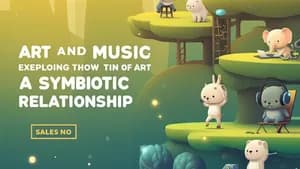Topic / Art and Music
Art and Music: A Symbiotic Relationship
Exploring the Intersection of Art and Music, examining how these disciplines complement and influence one another, from visual representations of musical concepts to the impact of musical forms on artistic styles.

Art & Music: Geometry's Shared Language
This article delves into the fascinating relationship between geometric patterns in art and mathematical principles in music. It will show how harmonious ratios and geometric shapes resonate across artistic and musical creations, from Renaissance paintings to classical compositions.
Published on May 6, 2025
Light & Shadow: Art and Music's Dynamic Duo
Discover the powerful role of light and shadow in both art and music. This article delves into how artists and composers use light/shadow and dynamics (loud/soft) to create depth, mood, and narrative, drawing parallels between visual and auditory experiences.
Published on May 3, 2025
Art and Music: Exploring Textural Depth
This article examines how the concept of 'texture' translates across artistic mediums. We will analyze how varied textures in musical composition, from smooth legato lines to complex counterpoint, find parallels in painting's brushstrokes, sculpture's surfaces, and other art forms.
Published on May 1, 2025
Art's Echo of Music: Structure's Shared Language
This article explores the influence of musical structure on artistic composition, demonstrating how musical forms like sonata or fugue have mirrored or inspired artistic structures in painting and sculpture throughout history. Examples will include specific works and movements to highlight this fascinating interplay.
Published on Apr 27, 2025
Mastering Space & Perspective in Art & Music
This article examines how artists and musicians have used the concept of space and perspective to create depth, dimension, and a sense of immersion in their work. It compares methods used in painting, sculpture, and music composition to manipulate the audience's perception of space.
Published on Apr 25, 2025
Nature's Symphony: Art & Music's Shared Inspiration
This article investigates how both art and music reflect and interpret the natural world, exploring how artists and musicians draw inspiration from nature's forms, patterns, and processes to create works that evoke a sense of harmony and wonder. This exploration crosses artistic movements and cultures.
Published on Apr 22, 2025
Art & Music: The Power of Improvisation
This article explores the powerful role of improvisation and spontaneity in both artistic and musical creation, looking at how artists and musicians embrace unplanned moments to generate unique and innovative works. The article will demonstrate how improvisation transcends boundaries.
Published on Apr 20, 2025
Art & Music: Geometry's Shared Language
This article explores how geometric patterns and principles appear in both visual art and musical composition, showcasing mathematical harmony as a fundamental element in creating aesthetically pleasing works. Examples in diverse cultural traditions will be featured.
Published on Apr 18, 2025
Light & Shadow: Art and Music's Dynamic Duo
This article examines the use of light and shadow in art and music, drawing parallels between chiaroscuro techniques in painting and the dynamic use of volume and intensity in musical pieces. The interplay of light and shadow will be shown as a tool for emotional expression in both mediums.
Published on Apr 15, 2025
Art & Music: Exploring Textural Depth
This article delves into the role of texture in both art and music, demonstrating how tactile qualities and surface treatments in art correspond to the layers, densities, and timbres found in musical compositions. We'll explore how artists and musicians create a sense of depth and richness through texture.
Published on Apr 14, 2025
Visualizing Music's Abstract Concepts
This article investigates how artists have visually interpreted abstract musical concepts, such as dissonance and consonance, exploring techniques they use to transform intangible sounds into tangible visual forms. Examples of artwork directly inspired by musical compositions will be discussed.
Published on Apr 11, 2025
Art & Music History: Parallel Movements
This article explores the surprising connections between artistic movements and musical genres, demonstrating how historical periods often saw parallel developments in both art and music. We'll examine specific examples showing shared themes, aesthetics, and underlying cultural forces influencing both disciplines.
Published on Apr 8, 2025
“All perceiving is also thinking, all reasoning is also intuition, all observation is also invention.”
— Rudolf Arnheim
